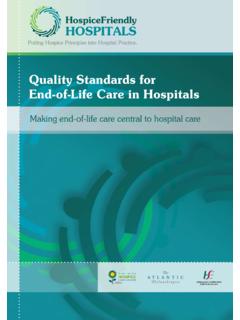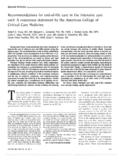Transcription of Grief at work - Hospice Foundation
1 Grief at workDeveloping a bereavement policyBreffni Mc GuinnessGrief at workDeveloping a bereavement policyBreffni Mc Guinness2007 ISBN: 978-0-9534880-6-3 NotesPlease note: the information in this booklet was accurate at the time of writing, but may besubject to publishers and author make no representation, expressed or implied, with regard to theaccuracy of the information contained in this publication and cannot accept responsibilityfor any errors or omissions that may part of this publication may be reproduced, stored in a retrieval system ortransmitted, in any form or by any means, electronic, mechanical, photocopying,recording or otherwise without prior permission of The Irish Hospice Irish Hospice Foundation gratefully acknowledge the following for their contributionsto this publication:All of the people who, through their own experience of loss and Grief at work , haveprovided the impetus for the development of this Higgins for conducting the review of current bereavement policies and practices ina sample of Irish also to the following for their valuable professional contributions: Andrew Blair,Annette Carey, Jean Casey, Lorus Collum, Susan Delaney, Eimear Harding, ColmHumphries, Dr.
2 Tom Inglis, Martin Mc Cormack, Yvonne Nolan, John Whelan andBernadette to Julie Buckley, Caoimhe Gavin, Pauline Gregan, Nuala Harmey, Miriam Joyce andCarmel O Connor for their help and thanks to Jim Curran ISME, Gerry Flynn CIPD, Dr. Mary Hogan IMI, EstherLynch ICTU and Helen Fitzgerald IBEC for their valuable insights and suggestions inshaping the thank you to all of the staff of IHF who helped make this resource possibleespecially Eugene Murray, Orla Keegan and Caroline Mc GuinnessTraining OfficerIrish Hospice FoundationOctober 2007 Glossary of terms6 Abbreviations6 Foreword7 Introduction9 Chapter 1 Understanding Grief at work15 Chapter 2 Supporting employees who are grieving21 Chapter 3 Key points to consider in developing a policy29 Chapter 4 Implementation of policy37 Chapter 5 Useful bereavement resources41 Concluding remarks44 Appendix A Review of current bereavement policies and practices45 References51 Contents6 Grief at work Developing a bereavement policy Glossary of termsLossA person experiences a loss when they lose someone or somethingthat is of significance to Literally means to be robbed of something.
3 It refers to the loss thatone is adjusting natural adjustment to loss and change which can involve strongemotional, psychological, physical and spiritual The outward or public expression of the Grief we this publication the terms loss, bereavement and Grief are used Counselling ServiceCIPDThe Chartered Institute of Personnel and DevelopmentEAP Employee Assistance ProgrammeHSEH ealth Service ExecutiveIBECI rish Business Employers ConfederationICTUI rish Congress of Trade UnionsIHFI rish Hospice FoundationIMII rish Management InstituteISMEI rish Small and Medium Enterprises AssociationSIPTUThe Services, Industrial, Professional and Technical Union7 Grief at work Developing a bereavement policy One of the difficult certainties of life is that at various times it is touched very deeply by thehuman sense of loss. The death of a parent, sibling, family members, friends and workingcolleagues affects us in many different ways. Apart from the Grief itself it can create a sense ofinstability, of worry, concern and unease.
4 These emotions can express themselves in manydifferent forms in the workplace and can have deeply personal and wider Irish Hospice Foundation , and the author of this publication, Breffni McGuinness, havecreated an acute awareness among the organisations representing the Social Partners of thesense of understanding of the value, esteem and support we must accord our workplacecolleagues during a period of bereavement and trauma of Grief , as the booklet illustrates, has many manifestations and expresses itself inmyriad potential reactions physical, emotional and psychological. We must all learntherefore to cope with and manage the effect such loss brings to our own persons and ourworkplace environs. Grief at work - developing a bereavement policy provides a practical, sensible and sensitiveset of guidelines for those whose work centres on best human resource practice - employers,unions, managers and work colleagues. It is an invaluable asset to our increasing portfolio of best practice workplace relations commend the Irish Hospice Foundation for their innovative approach, their exceptionalservices and the excellence of the standards they bring to all of their endeavours within theHospice MulveyChief ExecutiveLabour Relations CommissionForeword I ve nothing against death I just don t want to be there when it happens!
5 Woody AllenDeath is an inevitable and normal part of life and work . It is a painful reality which all of ushave to face at some point in our lives, though as Woody Allen highlights most of us wouldprefer not to have to deal with it. death is challenging, especially at work where it can be seenas a taboo topic which is best avoided or at least, dealt with privately. death though, is more common that we might expectDeath though, is more common that we might expect. In 2002 there were 29,683 deathsrecorded in Ireland1. By taking even a conservative estimate of just 10 people being directly affected by each death ,this means approximately 300,000 or 1 in 10 of an organisation s workforce2could be directlyaffected each year by Study 1 Brian s storyBrian worked in a small manufacturing company. He was married to Jenny and they had a youngdaughter Helen. One morning in Spring as Brian was driving to work , he was involved in an accidentand was killed instantly.
6 The owner of the company was devastated as were the other workers. Theowner himself had some experience of bereavement as both his parents had died a couple of yearspreviously. He took some time to gather his thoughts and then called a meeting of all the workers. Heexplained what had happened from the information he had been given and said that the companywould facilitate those workers who wished to attend the funeral. He then asked a trusted colleague if he would accompany him to visit Brian s wife. This was adifficult task but later Brian s wife said that she really appreciated the visit. All of the workers wanted to attend the funeral so the company closed for that morning. Althoughthe funeral was very sad it allowed the workers to begin to grieve and to express their sympathy toBrian s wife and family. The owner and some of the workers really missed Brian. They found themselves talking about himand getting upset at times over the following months.
7 As Christmas approached, they decided tomake a collection for Brian s child. It was a way of remembering him and also being of practical helpto his wife and family. 9 Introduction1 Source Central Statistics Office 20022 CSO 2002 ((Total deaths = x 10) /Population over 15 = ). Grief at work Developing a bereavement policy 10 Some months later the anniversary of Brian s death was approaching and the owner asked theworkers to think about how they might do something to remember Brian. There were lots ofsuggestions from memorial football competitions to putting a plaque on the wall of the they decided to plant a tree at the entrance to the factory. The owner agreed that theywould close the factory for an hour on the anniversary of Brian s death and have a small ceremonyto plant the tree. He invited Brian s wife and daughter to come along, and they were delighted to memorial ceremony was both painful and healing. It brought up the sadness of Brian s death butalso allowed the workers to remember him and to provide support to his wife and daughter and toeach other.
8 Planting the tree beside the entrance to the factory, helped the workers to grieve. Itmeant that Brian was not forgotten but was now being integrated into the continuing life of theworkplace in a new way. Brian s story is an example of how the very tragic situation of an employee dying can besensitively handled when the owner or manager has some understanding of the grievingprocess. In the short-term he facilitated the other workers by giving them accurate information aboutBrian s death and allowing them to attend the funeral. In the following months while the workcontinued he was up front about how he missed Brian and how, at times, he felt sad. Thisgave people permission to do the same if they so wished and normalised the impact of thegrief. In the longer-term, he helped the workers and himself to grieve by organising the memorial toBrian. Encouraging the workers to think of appropriate ways of remembering Brian provided atask focus through which they could do some of their grieving.
9 The memorial itself gave peoplean opportunity and permission to grieve together, while offering support to Brian s wife andchild. It was short and simple, which meant that the workers Grief needs were respected whiledisruption to work was is an example of good practice in managing a tragic experience of Grief in a company. Italso shows that you do not have to be an expert on Grief to be able to make a positivedifference. The owner drew on his own experience, compassion and common sense to helphimself and the workers come to terms with the tragic loss of their all organisations are as fortunate in having someone as sensitive to Grief as this owner managers generally try to do their best for their employees around Grief , they may notfully understand its impact and how best to respond to those who are grieving. This can oftenlead to misunderstandings, as in the case of John s story below. Grief at work Developing a bereavement policy 11 Grief at work Developing a bereavement policy Case Study 2- John s storyJohn received a call while on company business abroad to say that his father had been involved inan accident.
10 The policeman on the other end of the phone was reluctant to give too many details,but recommended that John return home immediately. John felt intuitively that his father wasdead. He asked the policeman if this was the case. The policeman did not want to say what theexact situation was over the phone but John insisted. Eventually, the policeman confirmed thatJohn s father was dead. The rest of that day was a blur. John s line manager who was with him, offered her sympathies,immediately arranged for a flight back, and accompanied John on the journey home. He was met atthe airport by relatives who filled him in on what happened. His father had been involved in anaccident and there was a possibility of foul play. The line manager and other senior members of staff from the company attended the funeral ritualsfor John s father. John had many practical matters to attend to over the next few days due to thesuddenness of his father s death . These included meetings with relatives, solicitors, bank andinsurance officials, and the coroner.











